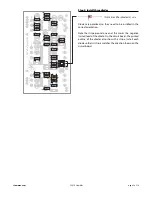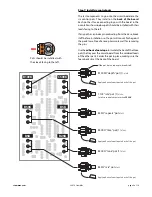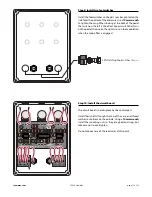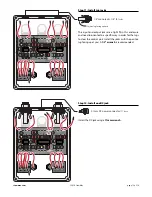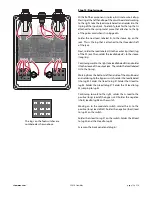
stewmac.com
©2018 StewMac
page 14 of 14
Here’s how the controls work:
Mix: Sets the output level of the effected signal. This should
be treated as a gain control/ master volume for the delay
line. Unity is around noon and everything above noon will
boost the delayed signal louder than the original. This is a
gain control so, like any pedal with a lot of gain, a hint of
noise and distortion at max setting is completely normal.
Tone: Most delay pedals are heavily filtered at the output
to remove the clock noise and other unwanted hash that
is common from extending the range of the delay time
beyond the limit of the circuitry. This usually leaves the delay
sounding dark and muddy, and disappears when hitting it
with dirt. The Disaster Transport has done away with a lot
of the heavy filtering and replaced it with a tone control
which allows the user to choose their desired sound and
results in more natural tape-like repeats. The tone control
is at its darkest fully counterclockwise and brightens as you
turn it clockwise. A good rule of thumb is to leave the tone
control between off (fully counterclockwise) and noon at
longer delay times. This will remove all the common noise
from hyperextending the circuit.
Time: From about 30ms fully counterclockwise to about
625ms fully clockwise.
Repeats: Sets the regeneration of the delay line. From one
single repeat fully counterclockwise, subtle repeats around
9 o’clock, strong naturally decaying repeats at noon, near
infinite repeats around 2 o’clock and full on self oscillation
fully clockwise.
Depth: Sets the depth of the modulation to the delay line.
The modulation is true pitch-shifting vibrato, higher depth
settings will give sea sick pitch bending, lower settings
will yield a more natural chorus/leslie/tremolo setting
depending on modulation rate and delay time. To achieve
a more natural modulation, the depth should be reduced as
the delay time is increased.
Rate: Sets the speed of the modulation. Goes from painfully
slow to way-to-fast allowing several different modulation
styles to reveal themselves.
Bypass: Turns the effect on/off.
Modulate: When activated, it emulates the decaying sound
of a tape delay. This makes the Rate and Depth knobs affect
that modulation as well. When the switch is turned off, the
other four knobs are the only ones that affect the signal, and
the delay sounds will repeat without decaying.
Power: Use a standard 9 volt DC power supply with a
2.1mm negative-center barrel (not included). We always
recommend pedal-specific, transformer-isolated wall-wart
power supplies or supplies with separate isolated outputs.
Pedals will make extra noise if there is ripple or unclean
power. Switching-type power supplies, daisy chains and
non-pedal specific power supplies do not filter dirty power as
well and let through unwanted noise. Do not run at higher
voltages! Current draw is 35 mA.
INPUT
OUTPUT
9V DC
REPEATS
RATE
TONE
TIME
DEPTH
MODULATE
BYPASS
MIX





